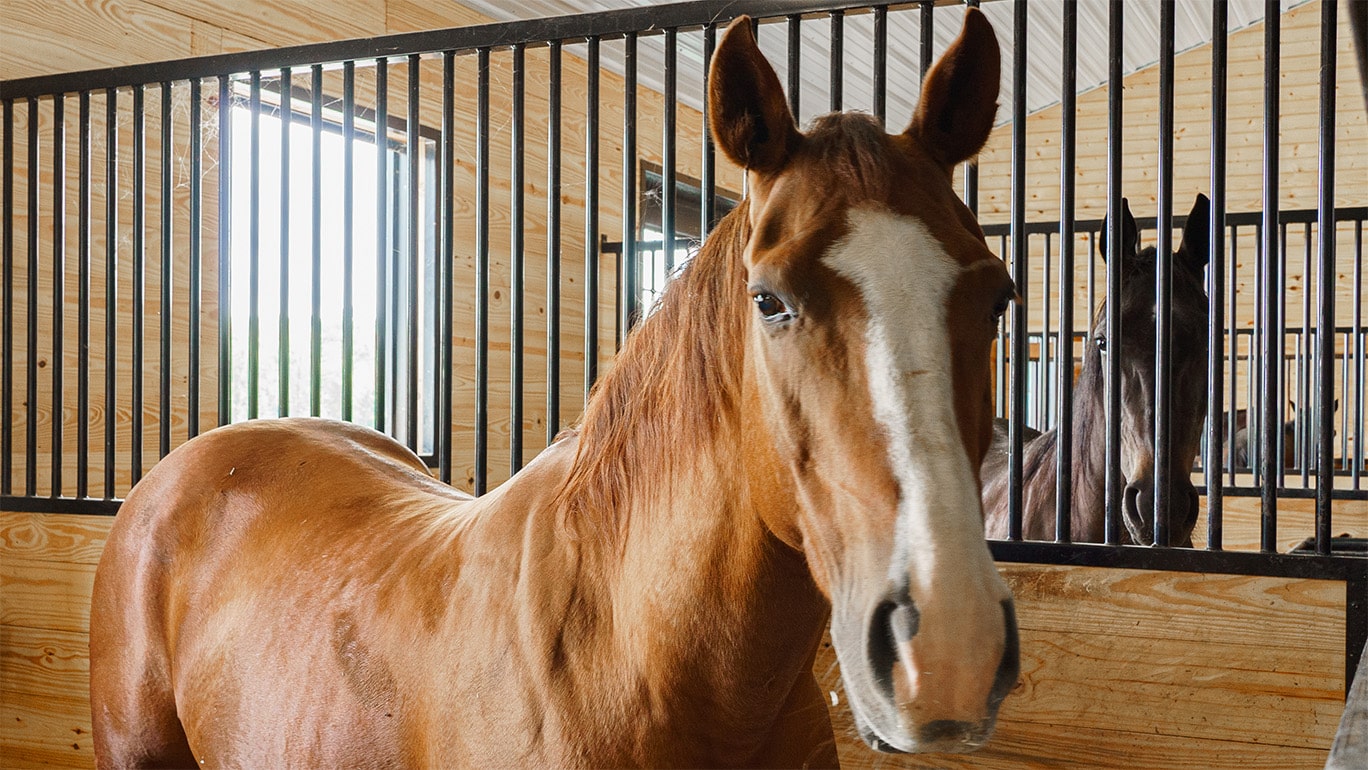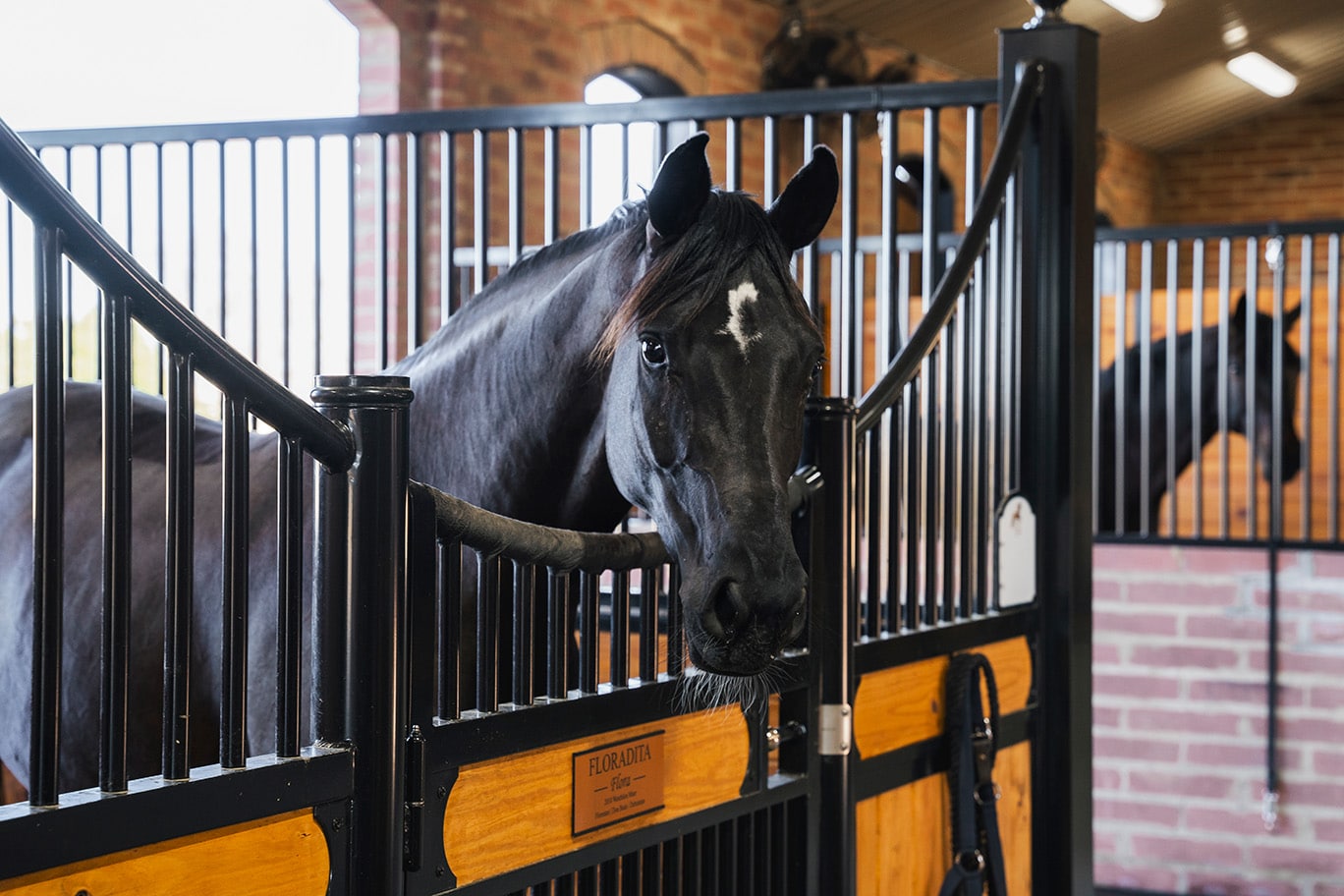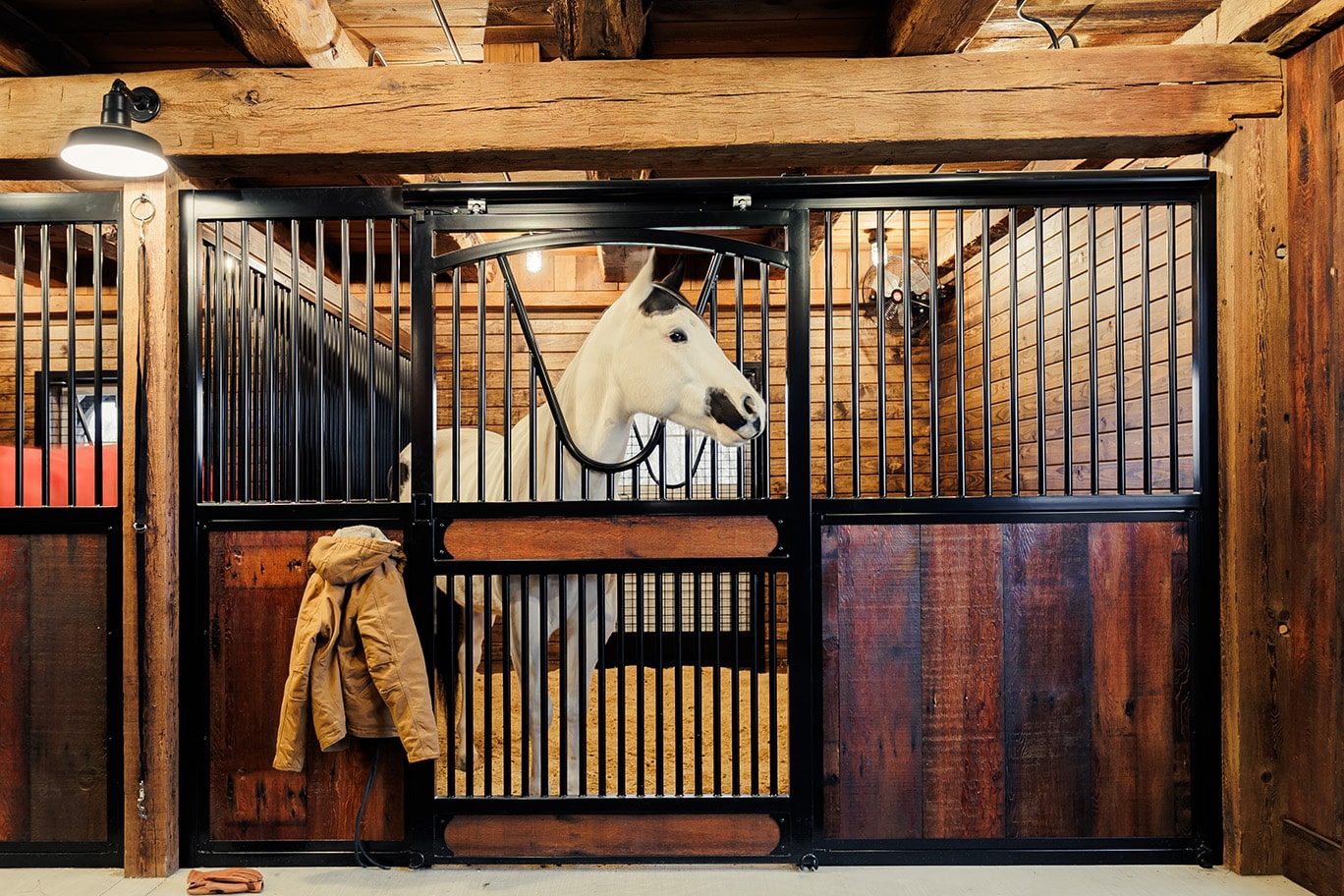In that kind of environment, horses graze, groom, play, and rest together, reading each other’s body language and feeling safest when surrounded by their companions. That sense of connection doesn’t disappear when a horse enters a barn—it just becomes harder to maintain.
Modern stabling often places horses in individual enclosures for safety, feeding control, and routine care. But the downside is that this setup can unintentionally isolate them, leading to stress, boredom, and even long-term behavior issues. Fortunately, there are ways barn design can meet those management needs while still respecting the horse’s natural drive to belong to a herd. Socialization isn’t just a “nice to have”—it’s central to equine well-being.

The Calming Power of Sight
Just being able to see other horses makes a big difference. When horses are kept in full visual isolation—say, behind solid stall walls—they often become anxious, hyper-alert, or vocal. But introduce a sightline to a neighbor, and their posture changes. They settle. Their ears relax. Their movement slows.
This isn’t just anecdotal. A study published in Applied Animal Behaviour Science found that horses with visual access to conspecifics (other horses) were less likely to display stereotypic behaviors such as weaving and stall walking compared to those housed in visual isolation (Visser et al., 2008). That sense of herd presence—even if they’re not physically touching—is often enough to put a horse at ease.
Stall dividers with protective grill tops or mesh-topped walls allow for this kind of visual contact while still maintaining the separation needed for feeding or safety. Horses can see who’s nearby, anticipate movement in the barn, and even form bonds across the aisle. The ability to observe others reinforces herd dynamics in subtle but meaningful ways.
Light Contact, Big Benefits
While visual access can ease isolation, many horses benefit from gentle physical interaction too. Mutual grooming is one of the most well-documented behaviors among bonded horses. It helps regulate social relationships, reduces cortisol levels, and even lowers heart rate. A study from the University of Copenhagen confirmed that horses are highly motivated to engage in social contact, and those that were allowed to groom each other exhibited calmer temperaments overall (Søndergaard et al., 2011).
In a barn environment, total physical separation isn’t always necessary or ideal. Small architectural features—like windows, drop-down yokes, or Dutch door openings—can offer just enough access for horses to sniff, nuzzle, or share a moment of connection. For stablemates with compatible temperaments, this limited touch can relieve stress and boredom without introducing the risk of full-body interaction.
These interactions aren’t just sweet—they serve a physiological purpose. Horses that can safely touch their neighbors tend to show fewer signs of anxiety, have steadier appetites, and are less reactive during work.

Reducing Boredom Before It Builds
When horses are cut off from social contact, and nothing in their environment changes day to day, they often develop coping behaviors that aren’t healthy in the long run. Cribbing, weaving, stall pacing, and excessive pawing are often signs of frustration and mental stagnation. As Dr. Katherine Houpt has noted in her behavioral studies, many stereotypic behaviors in stabled horses can be traced back to social deprivation or environmental monotony (Houpt, 1981).
Providing visual access and controlled interaction can go a long way, but so can offering a broader view of the barn and the outside world. Stall doors that are open at the top or Dutch doors that allow horses to stick their heads out increase sensory input—they can watch people and horses moving through the aisle, hear activity in the feed room, and observe outdoor changes. This kind of light stimulation helps horses feel more engaged in their surroundings, rather than trapped in a static space.
The more opportunities a horse has to see, hear, and respond to the world beyond their stall, the less likely they are to create their own repetitive habits out of frustration or stress.
Not Every Horse Wants the Same Thing
One of the challenges of designing for socialization is that horses aren’t all alike. Some are playful and social, while others are more introverted or easily overstimulated. And just like people, a horse’s social needs can change with age, injury, or shifting dynamics in the barn.
That’s where flexibility in design really matters. Adjustable stall partitions make it possible to open up space between horses that get along—or close things off when they don’t. Horses who share a calm bond may benefit from a wider shared visual field or even partial contact, while others may need a quiet corner where they feel secure and left alone.
This is especially relevant in training barns or show stables where horses are coming and going often. Being able to adjust a stall to suit the current horse, rather than working around a fixed structure, makes it easier to keep stress levels low. Long-term behavioral stability often hinges on our ability to respond quickly to these subtle needs.

The Noises We Don’t Always Notice
We often think about lighting, footing, and airflow when designing a barn—but sound is just as important, especially when it comes to social harmony. Horses are extremely sensitive to sudden or harsh noises. A squeaky hinge, a banging stall door, or the sharp clank of a metal latch might not seem like much to us, but to a nervous or reactive horse, these sounds can be jarring.
Over time, this constant state of alertness wears on the horse’s nervous system. It affects how they eat, how they rest, and how they respond to handlers. In group settings, one horse’s startle can ripple across the barn, affecting neighbors who were previously calm.
Choosing quiet-closing hardware and soft-operating stall doors reduces the ambient stress horses experience. A quieter barn environment supports better rest, a more relaxed daily routine, and healthier social dynamics among neighbors.
Letting Horses Be Horses—Safely
Encouraging social interaction comes with some practical concerns, too. Even friendly horses might kick, bite, or push against barriers if they get excited. That’s why it’s important to plan for the occasional outburst, especially if your stall design includes shared sightlines or light contact zones.
Materials like rubber wall liners and kick-resistant boards can absorb impact without injury. Horses that might throw a playful kick toward their neighbor—or simply act out of boredom—are much less likely to hurt themselves if their stall is made or lined with forgiving materials.
Again, this isn’t just about preventing damage to the barn. It’s about making space for natural behaviors in a way that doesn’t compromise safety. If we’re inviting horses to interact with one another, we need to ensure the environment can handle the occasional misstep.
Bringing the Barn Closer to the Herd
At its best, barn life can mimic some of the best parts of herd life. Horses don’t need full turnout to feel connected—though it certainly helps. Even small touches like sightlines, nose contact, and shared sensory experiences go a long way in helping horses feel like part of a group.
Designing with this in mind doesn’t require a total overhaul of tradition. It just asks us to observe our horses closely and ask how the space we give them affects their behavior. A quieter barn, a more interactive stall, and the freedom to see or touch a friend—all of it contributes to a horse who feels safe, engaged, and part of something bigger.
References
- Visser, E. K., Ellis, A. D., & Van Reenen, C. G. (2008). The effect of two different housing conditions on the welfare of young horses stabled for the first time. Applied Animal Behaviour Science, 114(3-4), 521–533.
- Søndergaard, E., Jensen, M. B., & Nicol, C. J. (2011). Motivation for social contact in horses measured by operant conditioning. Applied Animal Behaviour Science, 132(3-4), 131–137.
- Houpt, K. A. (1981). Equine Behavior Problems in Relation to Humane Management. International Journal for the Study of Animal Problems, 2(6), 321–336.